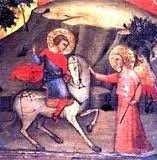Lying inside Rotonda di Montesiepi or Montesiepi's Hermitage in Tuscany, there is what is known as St.Galgano's Sword, it has been embedded in a stone for over eight hundred years which is around the time that Geoffrey of Monmouth was writing his Historia Regum Britanniae, it is in this work that we get the first glimpses of the legendary Arthur. Was it from this sword we see below that Monmouth got his inspiration?
However, whose to say that it was not the other way around, after all Arthur's and Galgano's tale is a mirror image of each others, they both occur at almost the same time, could it be that Monmouth's Caliburnus, was used by the people of Tuscany to explain their sword and Arthur's Sword in the Stone tale begins here.
Saint Galgano was born Galgano Guidotti in 1148 in Chiusdino, a village in what is now the modern province of Siena in Italy. Galango was said to have been a medieval Tuscan knight, the son of a feudal lord. Galgano had a reputation for selfishness and being somewhat of a rebel in his youth. Galgano, after have a vision of the Archangel Michael, saw the error of his ways, abandoning his old life for that of a hermit at Rotonda di Montesiepi. To prove his total commitment to his new cause Galgano plunged his sword into a large stone forcing it through the rock up to its hilt, thus changing the sword into a cross a symbol of his new found piety. Galgano died here on 30 November 1181 and since then pilgrims have arrived in large numbers and miracles have been performed. A papal commission was set up in 1185, after which Galgano was canonised in 1190. For centuries the sword was thought to be a fake, but researchers revealed in 2001 that the sword is in fact, twelfth century. The University of Pavia, who tested the metal of the sword also used ground penetrating radar analysis and revealed that beneath the sword there was a cavity in which is thought to be the body of Galgano. Incidentally, in the church, there are two mummified hands and these too are twelfth century. A local legend says that anyone who tried to remove the sword from the stone had their arms ripped off.







 RSS Feed
RSS Feed
